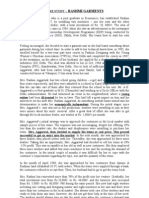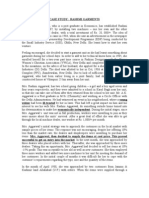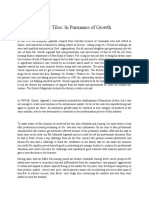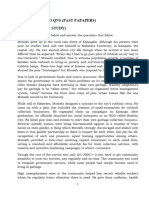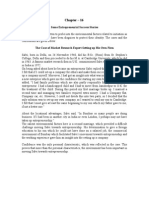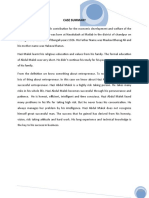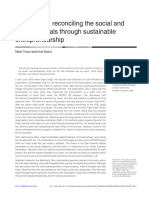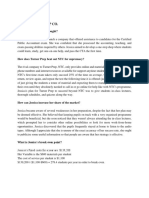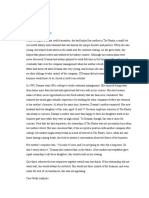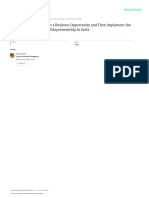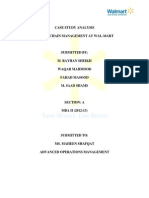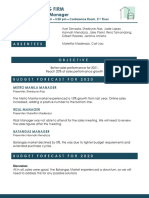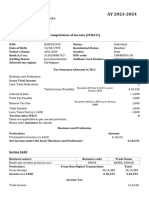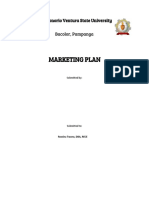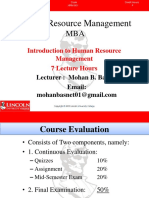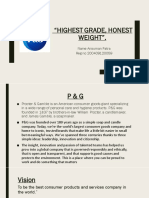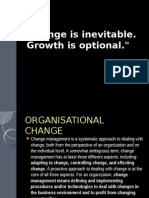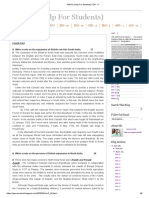Case study – Unit – 2 - Startup & New Venture Management
Rashmi Garments
Mrs. Rashmi Agarwal, who is a post graduate in Management Studies, has established
Rashmi Garments, in May, 1987, by installing two machines — one her own and the other
purchased from a local dealer, with a total investment of Rs. 20,000. The idea of starting her
own business came in 1984, when she saw an advertisement in the newspaper for a one
month Entrepreneurship Development Programme (EDP) being conducted by the Small
Industry Service (SISI), Okhla, New Delhi. She learnt how to start her own venture.
Feeling encouraged, she decided to start a garment unit as she had learnt something about
garments during her school days. In order to add to her technical know-how, in 1985, she
enrolled herself for a two-year part time course in Fashion Designing with the Young
Women’s Christian Association (YWCA), New Delhi and completed the course in 1987. In
the meantime, on the advice of her husband, she applied for a shed to the Director of
Industries (DI) Delhi. The shed was allotted to her in Oct, 1986 at the Flatted Factory
Complex (FFC), Jhandewalan, New Delhi. Due to lack of sufficient space, Mrs. Rashmi
Agarwal, who had been earlier living in a joint family, had shifted to her newly constructed
house at Vikaspuri 25 km away from her unit.
Mrs. Rashmi Agarwal, has two school going children — a girl and a boy aged seven and four
years respectively, and they were admitted to a school in Karol Bagh near her unit, so that she
can take care of them after they returned from the school to her unit. Mr. A.K. Agarwal is a
Post graduate in M.Sc (Chemistry) and working as a Circle Officer with the Delhi
Administration. He had witnessed an event in his neighborhood, where a young widow had
been ill-treated by her in laws. This had left a great impact on him and his interest to see his
wife Mrs. Rashmi Agarwal, do something outside home turned into his determination to
make her economically independent. During the initial stages, since Mrs. Agarwal’s unit
was not in full production, workers were unwilling to join as they were unsure about the
units’ survival. After a great deal of effort she was able to get through the local machine
dealer, one worker at Rs. 1,000 per month.
Mrs. Agarwal’s initial strategy was to approach the customers in the local market with
sample pieces of her items. The response was not encouraging, despite her offering 10% less
than the market rate, the dealers and shopkeepers were unwilling to purchase her items. Mrs.
Agarwal, then decided to supply the items at cost price. This proved successful to get an entry
into the market. In the next month, she was approached by three dealers who placed orders
with her. Thereafter, she was approached by three more dealers. Taking this an opportunity,
Mrs. Agarwal had decided to sell her items at 10% -15% profit. This was acceptable to her
old as well as new customers. She then employed three more workers and added two more
machines to her unit for meeting the demand of her customers. In the initial couple of months
it was difficult for her to cope with the customer’s requirements regarding the type, size and
the quantity of the items.
�In the month of April 1988, she was approached by two customers from Jammu & Kashmir
land Allahabad (U.P.) with orders. When the items were supplied through a bank, the
customers refused to accept then. Then, her husband had to go to get the items back.
Mrs. Rashmi has reinvested more than 70% of the profit into her venture. Gradually, her total
investment rose from Rs.20,000/- to Rs. 40,000/- and the turnover also increased from Rs.
5,000/- to Rs. 60,000/- PM during the same period. She now had eight workers including one
cutting and designing master and eight machines in her unit and there were more than ten
customers in the local market. She always took care of her workers and was ready to help
them any time, however, she did not get their help at the time of her need. The workers would
always turn up late for work even when the customer’s demand was high. This created
tension in her mind. Her workers said that she was always ready to help them at the hour of
their need and that was why they used to work till late in the evening and some times even on
weekly holidays, however, at the same time, they also had their personal problems and
limitations.
Questions:
1. As a business consultant you are directed to advise Rashmi about development of
Business Model and importance of Go- to Marketing strategy for her garment Unit
(10 Marks)
2. Critically evaluate Mrs. Rashmi Agarwal as an entrepreneur on the basis of the
information given in the case (10 Marks)
3. What are the key factors responsible for the initial growth of Rashmi Agarwal (10
Marks)
XXXXXXXXXX
Instructions:
1. Word Process - using font Times Roman', size '12 points' and convert the same to
PDF document before submission.
2. Word Count Minimum 2000 – 3000 Maximum.
3. Zero percentage (0%) Plagiarism is allowed in your work and in case
,,
4. Your report should have;
Introduction
Summary of the case
Growth of Rashmi Garments
Solutions (Answers to given Questions)
5. Last date for the Submission: On or before 02.00 PM on 17th July 2021
On line submission only - Submit to Mr. Shantanu Sinha
Prof. Prince Francis

